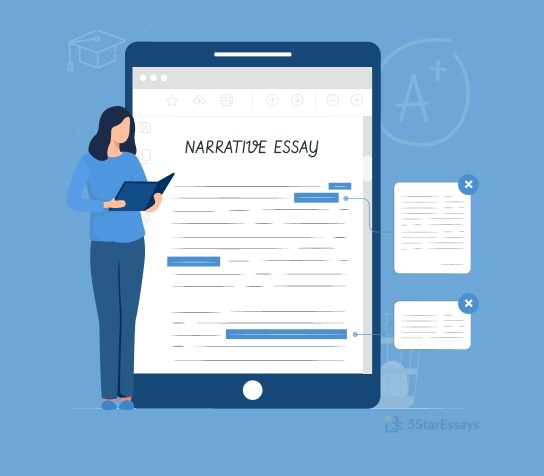A narrative essay is a type of academic essay in which the writer narrates a story. It is the most commonly assigned form of academic writing. Students have to face the narrative essay writing task quite often, so it is essential to know how to handle it.
Narrative Essay Outline Format
The narrative essay outline follows the standard structure. Like other types of essays, this essay normally follows a typical 5 paragraph essay format. The 5 paragraph outline includes one introduction paragraph, three body paragraphs, and one conclusion paragraph.
However, unlike other essays, the paragraphs of the narrative essay have specifically designated purposes:
1. Introduction Paragraph: Gives an insight into the story
2. First Body Paragraph: Discuss the rising action
3. Second Body Paragraph: Present the climax of the story
4. Third Body Paragraph: Provide the falling action
5. Conclusion Paragraph: Discussion of the lesson learned from the story
Paragraph Narrative Essay Outline Template
Let's look at the detailed 5 paragraph narrative essay outline for college students.
How to Write a Narrative Essay Outline?
A narrative essay is all about sharing the stories. Therefore, you need to organize your story into an essay format. As a writer, you are supposed to tell a story from your personal experience and why you are sharing that specific experience. Later, you need to discuss why this story or experience is important to share.
Let's look at how to craft an outline for a narrative essay. Follow the steps in the same sequence, and at the end, you’ll get a perfect outline. The writing process will become less stressful and daunting if you follow the steps given below.
1. Write the Introduction
The introduction paragraph is meant to engage the reader with the story. The first paragraph plays the most crucial role in making an impression on the reader’s mind. It allows you to share your perspective and how it relates to you. The following elements are involved in writing a strong narrative essay introduction.
- Create a Hook Statement Draw the reader in with an intriguing and attention-grabbing hook statement. Create a strong hook that makes your reader want to read further. You can use a quote, rhetorical question, or fact to create a persuasive hook statement.
- Set the Scene: Give your reader an idea of what is going to happen. Do not tell the whole story; just give a glimpse into it and keep your reader intrigued. Tell the reader how the points of the story relate to you.
- Define the Thesis Statement: Finally, tell your reader what your story is all about with the help of a thesis statement. Give a sneak peek of what is about to come but avoid telling the lesson you have learned from the situation yet; just give a hint.
2. Draft the Body Paragraphs
The main body of a narrative essay is the most important part because it tells the whole story. This is where you state the facts, provide examples, give details, and guide the reader through the plot. According to the five paragraphs essay structure, it has three body paragraphs, but it can depend on the length and word count.
Below elements must be kept in mind while writing the narrative essay body paragraphs:
- Write Chronologically: The timelines of a story should be presented in chronological order. Otherwise, the reader will get confused, and it becomes hard for them to understand the story. To keep your paper organized, you should present things in sequential order.
- Share the Relevant and Vivid Details: As a narrative essay is all about creating a mood and scene to follow, do that creatively. Set up the story with descriptive and concise language. Provide the reader with the most important details of your story. These details may include the characters, setting, plot, and the onset of the story.
- Avoid Narration Deviation: The narrative essay is usually written in the first person unless you share someone else’s story. The third-person narrative only works best when you are telling a story you heard from someone else.
3. Write a Compelling Conclusion
The conclusion paragraph is the final section of the essay where you give some final comments about the story. Summarize your essay and connect your reader back to the story. Follow these steps to write an impressive conclusion.
- Restate Some Key Details: Restate the thesis statement and some key details you have shared in the body. It will help you connect your reader with your story.
- Share the Lesson: Stress the lesson you have learned from the story and leave the reader with something to think about.
- Call to Action: In the end, provide a call to action that convinces the reader to think more about the topic.
Narrative Essay Outline Worksheet
Use the given worksheet below to write a narrative essay with ease.
Narrative Essay Outline Example
Here are some narrative essay examples and samples for your convenience. Use these templates and learn to write a good narrative essay easily.
Narrative Essay Outline for Middle School
College Narrative Essay Outline
Personal Narrative Essay Outline Template
Descriptive Narrative Essay Outline
Literacy Narrative Essay Outline
However, if you still have some concerns about writing a perfect outline, you can always contact our expert essay writers. 5StarEssays.com is a legit and reliable online essay writing service that connects you with highly qualified and professional writers ready to help.
Whether you need someone to write my narrative essay, craft a descriptive paper, or assist with any other academic assignment, you can trust us to deliver exceptional quality every time.
So waste no more time — place your order now and get professional custom essay writing help tailored to your academic needs!








